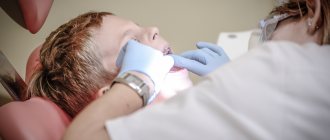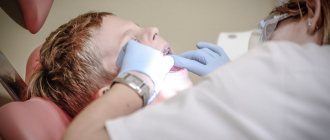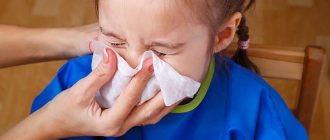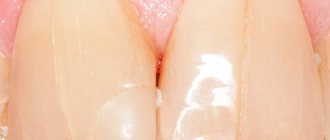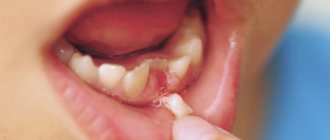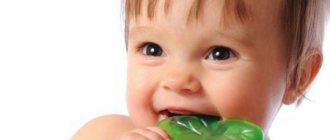Teething in an infant is a very exciting moment in the life of the baby and his parents. And although teething is a physiological process, almost all children experience discomfort and anxiety during this period. From the point of view of a scientific approach to this problem, the difficulty lies in the fact that with all the variety of teething symptoms from mild restlessness and moodiness, increased salivation to an increase in body temperature to high numbers and signs of impaired digestion, increased colic and diarrhea, there are no sufficient diagnostic criteria to connect all these numerous symptoms to the root cause. Nevertheless, many parents and some practicing pediatricians are still ready to blame the baby’s teething for almost all the troubles that befall them in the period from 5 - 6 months to one and a half - two years, when the teething process is mainly teeth should already be completed.
Most children begin teething between the ages of 4 and 7 months. As a rule, the eruption of each tooth lasts from 2 - 3 to 8 days. During this time, it is possible to increase body temperature to 37.4 - 38.0 degrees. At the same time, high temperature (from 38.0 and above) usually lasts no more than 2 days. Nasal discharge during the period when teeth are erupting is usually transparent, liquid, and should not contain pathological impurities: pus, greens, etc. Cough during teething is caused by saliva entering the nasopharynx and larynx area, which is released in large quantities. Cough due to teething does not require treatment. Regarding diarrhea, pediatricians sometimes differ in their opinions: some believe that diarrhea (loose stool) is not directly related to teething. And yet, studies have shown that from 10 to 30% of children have frequent and/or loose stools during teething. This is also explained by the large amount of saliva secreted, which enhances intestinal motility.
Teething or infectious disease
However, most modern pediatricians agree that such symptoms in an infant as: long-term, over 2-3 days diarrhea, cough, vomiting, fever (increase in body temperature above 38.5 degrees) are most often caused by infection, and not just teething teeth. Therefore, with any of the above symptoms, it is necessary to examine the child by a pediatrician, and only after other causes of increased body temperature have been excluded, efforts should be concentrated on helping the baby to reduce the discomfort from teething.
When does a baby's first teeth erupt?
All babies cut their teeth according to their own individual program: for some this process begins earlier, for others later. As practice shows, most children have their first tooth between the ages of 6 and 8.5 months, and by the age of one year, every healthy child has at least one baby tooth in their mouth.
At the age of three to four months, the teeth that are preparing to erupt begin to make themselves known quite actively: the baby becomes capricious, cries, and tries to bite everything that falls into his hands.
The very first to appear are usually the two lower ones, located in the center of the tooth (lower central incisors or “ones”). Then - the central upper incisors, followed by approximately ten months of age, the upper “twos”, or lateral upper incisors, erupt. By eleven to twelve months, the lateral incisors can be seen on the lower jaw. Thus, ideally, a one-year-old child is the happy owner of eight baby teeth.
By about sixteen months, many babies already have their first molars at the bottom and top. Fangs (“threes”) appear above and below later, in the eighteenth to twenty-second months of a child’s life. The upper and lower second molars erupt between 24 and 33 months of age. But again, it should be remembered that this process is individual and the order of teething may also be different.
Often teeth grow in pairs: two, and sometimes four at a time. Girls generally erupt teeth earlier than boys. By the age of 2.5-3 years, a child can find a full set of twenty fully erupted teeth.
Caution must be exercised if a child who is almost one year old does not have a single tooth. In principle, some children may have a congenital feature in the form of late teething, but you should not draw any conclusions on your own; you should definitely consult with a qualified specialist who, if necessary, will prescribe additional examinations.
Causes of late teething in children:
- hereditary predisposition, which is a variant of the norm and can be traced in other blood relatives;
- decreased thyroid function;
- rickets;
- diseases of the digestive system;
- disorders of enzymatic (fermentation) metabolism;
- pituitary insufficiency;
- lack of calcium in the child’s body;
- genetically determined diseases.
For the baby himself, the process of teething can proceed in different ways. Some children experience virtually no discomfort, others suffer from pain, their sleep is disturbed, their appetite worsens, their temperature rises (up to 38-39̊C), salivation increases, they may experience nasal congestion, a wet cough (due to excessive salivation), constipation, or, conversely, , increased bowel movements.
Experts recommend starting to care for your child’s oral cavity even before the first teeth erupt: in the morning and evening, before going to bed at night, the child’s gums should be carefully wiped with a swab previously moistened with warm water. After the first teeth appear, you need to clean them with a special finger brush, which can also be used to massage the gum tissue. The front teeth should be brushed with vertical movements, the side teeth should be brushed in a circular motion.
The Healthy Smile network of dental clinics employs experienced pediatric dentists, with whom you can schedule your child for a free consultation.
The Healthy Smile clinics provide discounts for regular customers, family discounts, various payment methods are possible, and the list of promotional offers to reduce the cost of certain types of services, including for children, is regularly updated.
Teething: how to help your baby
This may require a fair amount of patience. During such a difficult period, you should take the baby in your arms more often, caress him, distract him from unpleasant sensations with toys, turn on pleasant, soothing music, and you can sing if natural abilities allow. A walk in the fresh air can also have a calming effect. Children who are breastfed, during teething, begin to cry more often and ask for the breast, and a loving mother needs to be patient, putting the baby to the breast every time, even if he grabs the nipple areola harder than usual during feeding. To satisfy the child’s need to chew something and hold something in his mouth, you can naturally use special rubber rings or toys, so-called teethers. You can offer your child dry food or baby cookies.
Currently, pharmaceutical companies offer a wide range of different products, primarily in the form of gels to “soothe the gums.” In general, most of these products contain painkillers such as lidocaine. You should not abuse these funds. They are not completely harmless; the anesthetics they contain can have an adverse effect on the child’s nervous and cardiovascular systems, and most importantly, they can cause serious allergic symptoms and contribute to the exacerbation of atopic dermatitis (diathesis) in children prone to allergies. In connection with the above, I can recommend, to reduce swelling and inflammation of the gums during teething, such special dental anti-inflammatory drugs for topical use as Cholisal gel, which can be applied to the baby’s gums 2-3 times a day, but must be rubbed in (not too much). of course) with light massaging movements over the entire surface of the gums, and not just putting it in the child’s mouth.
In addition, you can give a child suffering from teething special homeopathic drops, for example Dantinorm baby, according to the instructions for the drug. In any case, if the disturbing symptoms described above in this article appear, I advise you to play it safe once again and call a pediatrician to the home of a child with a high fever. A professional should give his diagnosis and recommendations.
Eruption of baby teeth in children
Eruption of baby teeth in children
The appearance of baby teeth in a baby is quite a difficult process for both children and their parents. As a rule, it is accompanied by red and swollen gums, lack of appetite, moodiness, crying, and often elevated body temperature. It will be useful for many parents to know how a baby tooth works, what is the timing of teething in children, and what parents should do during this difficult period.
Timing of teething
From 4 to 7 months, you can notice how the first teeth are pushed through the gums. These are the lower front teeth, which are called the mandibular frontal incisors. After 4-8 weeks, the upper four incisors, frontal and lateral, appear. About a month after them, two lower lateral incisors erupt. The lateral chewing teeth begin to appear next. First the rearmost ones, then the penultimate ones. And finally, by the second birthday, fangs should have erupted. Most children by this age have a full set of 20 teeth. These are fairly general rules, but if your baby has a significant delay in teething - retention, contact pediatric dentistry for advice. This most often occurs in the canines, but can also affect incisors and molars. The norm is a delay in eruption of 1 or 2 months.
What is accompanied by the eruption of baby teeth?
From the moment your baby starts teething, you may notice his bad mood, increased salivation and a desire to chew on something. For some children, this process is painless. Others experience short periods of irritability, pain, and disturbances in sleep and eating patterns. Teething can cause significant discomfort for your baby, and if your baby seems overly excited, contact your pediatrician and pediatric dentist.
Although weak, swollen teething gums may cause a mild fever in a baby, the teething process usually does not cause a significant fever or stomach upset (diarrhea). If such symptoms occur, it is most likely caused by something else, and you urgently need to consult a pediatrician.
Relieving Teething Symptoms:
- Regularly wipe your baby's face with a special towel to remove saliva and prevent skin irritation.
- Place a clean, flat cloth under the baby's head to absorb any drool. When the napkin gets wet, you won't have to re-make the sheet.
- Give your child something to chew on. Make sure the item is large enough that your child won't swallow it or chew it into small pieces. Special rings for teething baby teeth, which are sold in pharmacies, are also effective. Do not buy rings with liquid inside - they will burst. If you are using rings, do not freeze them until they turn to stone to avoid damaging your weak gums.
- Never tie a teething ring around your baby's neck to avoid getting caught in the band. Gently massage your baby's gums with a clean finger. Dental gel is often used to relieve teething pain in infants. Its application gives a temporary effect.
- Never put aspirin or other tablets on your teeth, or rub alcohol-containing solutions into your gums.
- If the child is not feeling well, many parents give their child paracetamol. Remember that paracetamol is not recommended for use by children under 3 years of age! Be sure to consult a specialist!
It is extremely important to maintain oral hygiene when teething baby teeth, since due to the peculiarities of their structure, up to 80% of pathologies (pulpitis, periodontitis, periostitis) develop precisely during the formation of the bite in children.
Share:
How to avoid teething problems?
Many parents attribute the symptoms of serious illnesses in their infants to signs of teething. It should be noted that high (from 38 degrees) temperature, vomiting, diarrhea and cough are not associated with teething - these are signs of acute respiratory or intestinal infections.
During the period of the appearance of baby teeth, cracks and microtraumas appear in the tissues of the mucous membrane, which can become infected. To prevent suppuration and inflammation, you need to monitor your child’s oral hygiene and take care of newly emerged teeth. Baby teeth are more susceptible to decay than molars (this is due to weak enamel), and the carious process affects several teeth at once and can affect the roots of permanent teeth, which are located in the gums.
In addition, you should pay attention to the shape, color and location of the teeth - in case of any pathologies, you should consult a dentist.
The most important thing that all babies need during the period of growth of baby teeth is the affection, patience and love of mom and dad. Teething is a difficult period in a child’s life, but with the appropriate attitude of parents, it will pass as easily and painlessly as possible. For black metal classification, please follow the link.
How does a baby cut teeth?
In babies, the eruption of primary teeth occurs mainly between 6 and 8 months of life. The lower central incisors erupt first, followed by the upper ones. A short time later, at 8-12 months, the lateral incisors erupt, first on the lower jaw, and then on the upper. Thus, a one-year-old child should have 8 teeth.
At 14-16 months of age, temporary chewing teeth erupt, at 16-20 months, fangs emerge, and by 20-30 months, the second chewing teeth appear. You need to be wary if the sequence of eruption is disrupted (for example, the lateral incisors on the lower jaw erupt first, and only then the central ones). Because of this, there may be a risk of developing a malocclusion. Most often, the cause of this problem may be a severe deficiency of phosphorus and calcium, and, consequently, vitamin D in the baby’s body. To prevent this, a nursing mother must monitor her diet. When choosing an adapted formula for a child, give preference to those that contain vitamin D in a higher dose.
What to do if teeth are delayed?
There may be two reasons why there are no symptoms of teething - a physiological feature or pathology of the body. Most often, teeth are delayed due to a lack of vitamin D or, in other words, rickets, as well as hormonal disorders (for example, hypothyroidism). In rare cases, children are diagnosed with adentia - a congenital absence of tooth root primordia in the gums. Only a dentist can make such a diagnosis after a detailed examination of an x-ray of the oral cavity.
How to alleviate the child's condition?
If the baby's teething process is difficult, parents need to do everything to alleviate his condition. If your baby refuses to eat, you should not force-feed him or set a strict schedule, as this will only make the problem worse. If the temperature rises, you can use antipyretic syrups (for example, Ibuprofen) according to the instructions.
One of the means to relieve discomfort is a light massage of the gums, which should be done with a clean finger wrapped in a piece of gauze. Movements should be careful and soft so as not to injure delicate tissues. You can buy your baby a teether - a ring or a toy with thermogel inside: it will relieve swelling, pain and bring relief to the child. In addition, pharmacies sell medications that eliminate discomfort, itching and pain in the gums.
Table. Teething preparations.
| Drug name | Advantages | Flaws |
| Quickly relieves discomfort, prevents the development of inflammation in the gum tissue | The drug contains lidocaine, so it is not recommended for use if you have allergies or are breastfeeding. | |
| It has a long-term effect (about eight hours) and an aniseptic effect, does not reduce the sensitivity of the tongue, is not washed off by saliva, and does not contain substances that can cause allergies (in particular, lidocaine) | High cost, pronounced anise taste, which can cause some inconvenience to the child | |
| Instant cooling and analgesic effect, low cost | Short-term action, the gel contains lidocaine hydrochloride | |
| Herbal preparation, eliminates inflammation and pain, strengthens and heals gums, relieves irritation | Weak analgesic effect | |
| A combined agent with antiseptic and proto-inflammatory effects, relieves pain and itching | Contains lidocaine | |
| Quick effect, pain relief for two hours | Short-term effect | |
| Preparation with plant extracts, softening effect | Short and weak analgesic effect |
When using soothing gels, do not forget that they are medications and must be used strictly according to the instructions. Most drugs are used no more than 3-4 times a day and no more than three days in a row, otherwise they will become addictive and stop working. They cannot speed up teething or influence the process in any way - it will proceed naturally, in accordance with the developmental characteristics of the baby.
When do the first teeth appear?
The rudiments of dental roots appear in the child’s gums during pregnancy, starting from the twelfth week. The process of teething begins at about 4-6 months of age, but sometimes babies don't have their first teeth until after a year, and some babies are born with one or more teeth.
There may be several reasons for such phenomena:
- genetic predisposition to early or late appearance of teeth;
- quality of food, water and infant care;
- living conditions (climate, environmental situation);
- presence or absence of chronic diseases;
- general condition of the body.
Even in the case of twins (twins, triplets), the process of tooth growth can begin and proceed differently.
In other words, parents should not worry that the baby’s teeth are delayed by several months, but they still need to get advice from a specialist, as sometimes this can indicate pathologies and diseases.




